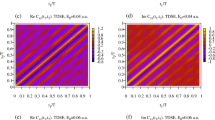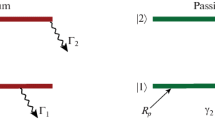Abstract
The present paper contains a mathematically exact, fully quantummechanical treatment of dissipation and fluctuations in a two-level system. We consider an atom with only two levels, which is coupled to the radiation field and to a system of negative temperature. As a consequence, the atom decays to the lower level and is pumped to the upper one alternately. Although the methods, which are developed, do not depend on this model, it has been chosen because of its applicability in laser theory. In fact, we will give in a second paper a fully quantummechanical treatment of a laser, using the results given here.
We discuss the motion of the atom in terms of its time-dependent “spin-flip” and occupation number operators, i.e. we use the Heisenberg picture. In such cases usually one writes down the nonlinear coupled system of equations of motion for the field and atomic operators. We, however, start with a transformation of the time evolution operator of the total system using the technique of disentangling, which has been developed byFeynman. Incidentally this transformation allows for a generalization of theWigner-Weisskopf theory of spontaneous emission, which will be published in a forthcoming paper. For the present purpose it permits us to write down the equations of motion for the atomic operators in terms of a mean motion, which refers to the coupled fields only through relaxation times and equilibrium values of the occupation numbers, and of fluctuating forces, which give the effect of the quantummechanical fluctuations of the fields on the atom. The mean or dissipative motion agrees with that of a 2×2 density matrix, which describesN identical atoms coupled to our fields. The fluctuating forces are given by operators and they are therefore noncommuting. Their properties are discussed in detail. An important result is, that they are not correlated in time. It is shown that they are responsible for the commutation relations of the atomic operators for all times. Such fluctuations do not occur in a density matrix description, because it contains already an averaging over fluctuations.
Our results show clearly that dissipation and fluctuations cannot be split in quantum mechanics, because the neglection of the fluctuations would violate the commutation relations.
Similar content being viewed by others
Author information
Authors and Affiliations
Additional information
Über einige Ergebnisse der vorliegenden Arbeit wurde auf der Tagung der Deutschen Phys. Ges., Würzburg, April 1965, berichtet.
Dissertation Techn. Hochschule Stuttgart 1965.
Mein herzlicher Dank gilt Herrn Prof. Dr. H.Haken für zahlreiche Diskussionen, die die Entstehung der vorliegenden Arbeit wesentlich gefördert haben.
Rights and permissions
About this article
Cite this article
Sauermann, H. Dissipation und Fluktuationen in einem Zwei-Niveau-System. Z. Physik 188, 480–505 (1965). https://doi.org/10.1007/BF01339878
Received:
Issue Date:
DOI: https://doi.org/10.1007/BF01339878




